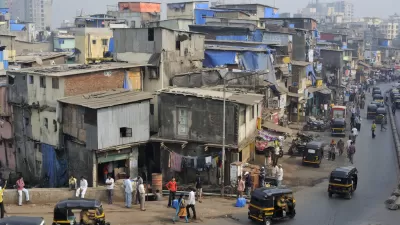Dr. Aseem Inam takes writers on urbanism and architecture to task for spreading stereotypes about "third world cities", particularly when used to generalize about urban form.
 The current economic crisis, increasing ecological concerns, and growing urban populations are remarkable opportunities for innovative thinking and strategic policies to redesign our cities.
The current economic crisis, increasing ecological concerns, and growing urban populations are remarkable opportunities for innovative thinking and strategic policies to redesign our cities.
In that regard, a March 29, 2009 article, entitled "Reinventing America's Cities: The Time is Now,"by the architecture critic Nicolai Ouroussoff in the New York Times was particularly welcome for a number of reasons. First, it appeared in a publication that is influential and widely read by the professionals and policy makers responsible for shaping our cities. Second, instead of the often fawning tone of articles of one-off spectacular buildings by star architects, this essay was measured, thoughtful, and highlighted modest yet significant efforts by architects, urban designers, and planners to redesign cities such as New Orleans, Los Angeles, New York, and Buffalo. Finally, the article avoids the singular and overly narrow visions for future cities that are commonplace: "green cities", "technology cities", and so forth. Anyone who has practiced in the field is well aware that cities are complex and multifaceted, and their design requires prioritizing multiple goals and making difficult tradeoffs between immediate needs (e.g. affordable housing) and long-term objectives (e.g. economic vitality).
However, the article reveals an important bias that is prevalent among American architects and urban designers, and that limits significant and consequential innovations in reinventing American cities: a condescending attitude towards so-called "third world cities."
In discussing plans for restoring the Los Angeles River to a more ecologically sound condition and the possibility of converting Wilshire Boulevard to an urban center through a concentration of public transportation and cultural institutions, Mr. Ouroussoff writes: "A citywide plan that anchored Los Angeles along two major axes-the green river and the asphalt boulevard-could save it from becoming a third world city." I have seen the phrase "third world city" being repeated over and over verbally and in writing as a condescending comment meant to evoke a lack of planning foresight, low design and development standards, and a general sense of disrepair and even chaos. There are several self-imposed constraints that come with such thinking.

A careful observation of so-called "third world cities" in Asia, Africa, and Latin America reveals that these cities possess the same qualities that most American urban centers aspire towards, albeit in different forms. The historic centers of cities such as Mexico City, Mumbai, and Marrakech, are full of life and vitality, and have been so for centuries. One finds a rich mix of land uses, including everything from open air markets to schools and workshops that produce stunning handicrafts, and a vital pedestrian street life of people going to work, to school, and perhaps most important of all, to interact with each other socially. Many business interactions are in fact social interactions, conducted over a cup of tea or as part of a longer conversation-patterns of behavior that are crucial to a healthy social fabric. These historic centers represent some of the most promising aspects of cities as places of commerce, culture, and conversations that lead to great understanding, entrepreneurship, and even larger social movements.
American cities can also learn from the manner in which "third world cities" live comfortably to this day with history, instead of either treating it as a museum frozen in time or as something to be emulated in an uncritical manner. These cities are among the oldest in the world, even more so than the European cities that Mr. Ouroussoff and practicing urbanists tend to place on a pedestal. In "third world cities", centuries old architecture lives comfortably with new construction much in the same way as ancient social and cultural traditions evolve alongside newer social norms and structures. The older structures are exemplars of ecologically sensitive design long before it became fashionable for American and European academics and star architects to expound the virtues of sustainability and green design. For example, centuries old buildings are cool in the summer without computer-aided sensors; rather, they do so in highly-cost effective ways, by orienting windows away from the summer sun, providing simple shading devices, construction consisting of thick walls, and fenestration that encourages cross ventilation. For example, I remember growing up comfortably in the 100 degree heat of India without air conditioning or adjustable thermostats.
As American designers invent innovative ways to reduce our ecological footprint on the earth, they would do well to observe the centuries-old low-impact lifestyles of those in "third world cities". Thus, along side green roofs, bio swales, and permeable surfaces, we should also be designing simple, but widespread, ways of recycling materials on a daily basis as part of a network of mobile street entrepreneurs and small scale economic activities such as repair and refurbishing rather than disposing of damaged goods, as is common in the U.S. and Europe. In "third world cities", so-called "green jobs" have existed for centuries in the construction industry for the repair and maintenance of existing buildings, recycling everything from shoes to typewriters, and using materials such as rammed earth and straw bales to construct modest structures.
Instead of demeaning so-called "third world cities", we would do well to observe, understand, and adapt such approach on a much more widescale basis. In order to truly reinvent American cities, we have to look farther afield at the resourceful design innovations of the cities of Asia, Africa, and Latin America .
Dr. Aseem Inam is a Visiting Lecturer in the School of Architecture and Planning, and a Residential Scholar at Simmons Hall at the Massachusetts Institute of Technology (MIT). Before coming to MIT, Aseem was an Associate and Senior Project Manager at Moule & Polyzoides Architects and Urbanists in Pasadena, California.

Alabama: Trump Terminates Settlements for Black Communities Harmed By Raw Sewage
Trump deemed the landmark civil rights agreement “illegal DEI and environmental justice policy.”

Planetizen Federal Action Tracker
A weekly monitor of how Trump’s orders and actions are impacting planners and planning in America.

The 120 Year Old Tiny Home Villages That Sheltered San Francisco’s Earthquake Refugees
More than a century ago, San Francisco mobilized to house thousands of residents displaced by the 1906 earthquake. Could their strategy offer a model for the present?

In Both Crashes and Crime, Public Transportation is Far Safer than Driving
Contrary to popular assumptions, public transportation has far lower crash and crime rates than automobile travel. For safer communities, improve and encourage transit travel.

Report: Zoning Reforms Should Complement Nashville’s Ambitious Transit Plan
Without reform, restrictive zoning codes will limit the impact of the city’s planned transit expansion and could exclude some of the residents who depend on transit the most.

Judge Orders Release of Frozen IRA, IIJA Funding
The decision is a victory for environmental groups who charged that freezing funds for critical infrastructure and disaster response programs caused “real and irreparable harm” to communities.
Urban Design for Planners 1: Software Tools
This six-course series explores essential urban design concepts using open source software and equips planners with the tools they need to participate fully in the urban design process.
Planning for Universal Design
Learn the tools for implementing Universal Design in planning regulations.
Clanton & Associates, Inc.
Jessamine County Fiscal Court
Institute for Housing and Urban Development Studies (IHS)
City of Grandview
Harvard GSD Executive Education
Toledo-Lucas County Plan Commissions
Salt Lake City
NYU Wagner Graduate School of Public Service





























